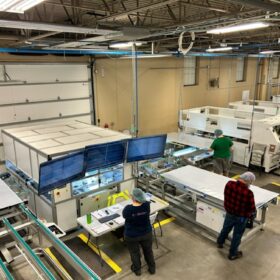Tesla continues scaling up energy storage business in China
The announcement of Tesla’s battery factory in Shanghai marked the company’s entry into the Chinese market. Amy Zhang, analyst at InfoLink Consulting, looks at what this move could bring for the US battery storage maker and the broader Chinese market.
Heliene, Premier Energies announce U.S. solar cell factory
Heliene is a solar module provider operating in North America, while Premier Energies is the second largest solar cell manufacturer in India.
WoodMac says global solar tracker shipments grew by 28% in 2023
Global tracker shipments reached 92 GWdc last year, according to WoodMackenzies’ latest report. The US accounted for the majority of the global market, with three US-based manufacturers, Nextracker, Array Technologies and GameChange Solar, ranking as the three largest shippers in the world.
How long do residential solar batteries last?
Multiple factors affect lifespan of a residential battery energy storage system. We examine the life of batteries in Part 3 of our series.
US engineers develop ChatGPT algorithm to design solar cells
OptoGPT is a new algorithm that harnesses the computer architecture underpinning ChatGPT. Its creators say that it will enable researchers and engineers to design optical multilayer film structures for a wide range of applications, including solar cells.
The Hydrogen Stream: New way to make hydrogen, fertilizer from ammonia
German researchers have developed a new way to liberate hydrogen from ammonia, while a new MIT study shows the need for stringent emissions regulations on ammonia combustion for maritime mobility.
Israel’s N2OFF enters solar business
Agri-food tech specialist N2OFF says it has entered the PV business by lending €375,000 ($407,000) to Israeli PV developer Solterra Renewable Energy. The loan is part of a larger €500,000 agreement, with the remaining €125,000 to come from other parties.
ReCreate unveils details of US solar cell, module factory
The new venture is expected to bring 2 GW of solar module manufacturing capacity to the US market within 18 to 24 months.
Nevada partly covers peak demand with 690 MW solar-plus-storage project
The US state of Nevada will meet 10% of its peak demand with the now-operational 690 MW Gemini solar-plus-storage project outside of Las Vegas.
Canadian government extends heat pump grant scheme
The provincial government of Prince Edward Island, Canada, has signed an agreement with the Canadian federal government to implement the Oil to Heat Pump Affordability (OHPA) program. The scheme offers grants to low- and medium-income households to install heat pumps and has nationally delivered more than 7,000 units to date.










